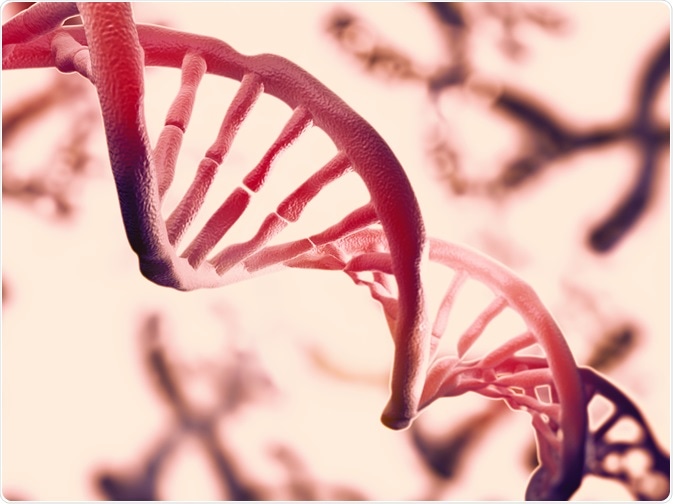DNA methylation is a form of epigenetics in which gene expression is encouraged or inhibited by the addition of a methyl group on cytosines. It is highly implicated in development, cell differentiation, and stem cells.
Pyrosequencing is a sequencing-by-synthesis method which can be applied to measure DNA methylation at CG sites.
 Image Credit: Liya Graphics / Shutterstock
Image Credit: Liya Graphics / Shutterstock
Analyzing DNA methylation
DNA methylation is carried out by DNA methyltransferases, which catalyze the reaction adding a methyl group to the carbon-5 of cytosines. The methyl donor in this reaction is S-adenosylmethionine (SAM), which is an intermediate product of the metabolism of methionine.
DNA methylation typically occurs at CG sites in mammals, which means that cytosine methylation occurs before addition to guanine. It is these types of sites which pyrosequencing can analyze.
Other methods, such as bisulfide sequencing, can also analyze DNA methylation at other sites. However, bisulfide sequencing and other techniques such as HPLC and methylation sensitive PCR are more time consuming, expensive, and can carry technical difficulties.
Pyrosequencing
Pyrosequencing is designed to find single nucleotide polymorphisms, also called SNPs. These can be artificially created at methylated CG sites by bisulfide conversion. The treatment, with sodium bisulfide, converts cytosine to uracil.
Methylated cytosine, however, is protected from this conversion and remains as cytosine. Uracil is further converted to thymine after PCR, which takes place after bisulfide treatment. A single biotinylated PCR primer is incorporated to separate two amplicon strands to create a single stranded DNA amplicon.
After PCR, the single stranded PCR amplicon acts as the DNA template for pyrosequencing. Pyrosequencing is a sequencing by synthesis method, which means it monitors the addition of complimentary nucleotides to a template DNA strand. The enzyme cascade includes DNA polymerase, ATP sulfurylase, luciferase, and apyrase.
There are two substrates: adenosine 5’ phosphosulfate, also called APS, and luciferin. To start, a sequencing primer is annealed to the single stranded DNA template. The addition of a single nucleotide spurs DNA polymerase to incorporate dNTP (deoxyribonucleotide triphosphate) on the strand, which releases pyrophosphate, also called PPi.
PPi reacts with APS in the presence of ATP sulfurylase, generating ATP. In turn, the ATP reacts with luciferin in the presence of luciferase, generating oxyluciferin, the process of which emits light.
The emitted light is detected by a CCD camera. The light peaks can be compared to give an exact measurement of the amount of methylation by looking at light emission of incorporation of C or T at C-G sites within the amplicon.
The light provides usable quantitative results which makes it useful for methylated DNA. The bioluminometric response is linear for consecutive addition of five nucleotides which are the same. This makes it suitable for quantifying the relative abundance of two individual nucleotides
Practicality of pyrosequencing
This PCR based method has several advantages. For one, it is reliable and has been applied for diagnostic purposes such as routine genotyping, detection of mutations, and identification of microbes. It is quick, as it can be completed within a day if starting with PCR.
Several assays and samples can be analyzed at the same time. For example, when using a 96-well format for PCR, 96 different assays can be done on one sample, or 96 samples for one assay.
The time needed for this technique depends on the number of dispensations, or sequence instructions where an instruction is one of the bases, required for the target region. Pyrosequencing can be applied to both specific gene elements and global methylation estimates.
However, it is not without its pitfalls. Setting up a pyrosequencing assay can be difficult, as they can be hard to design, and require extensive optimization. Furthermore, the bisulfide treatment is showing to be unable to tell the difference between 5-methylcytosine (methylated cytosine) and 5-hydroxymethylcytosine.
The aforementioned linear response of the bioluminometric response can also have some drawbacks. While it is suitable as it provides good quantitative results, the response is only linear when the nucleotides that are sequentially added are identical. If the sequence is variable and close to homopolymer reads, it may not be easily resolved. This can limit the quantitative accuracy.
Sources
- DNA methylation analysis by pyrosequencing.
- Analysis of DNA Methylation by Pyrosequencing.
- DNA methylation analysis by pyrosequencing.
Further Reading
- All DNA Methylation Content
- DNA Methylation – What is DNA Methylation?
- DNA Methylation: Eukaryotes versus Prokaryotes
- DNA Methyltransferase Enzymes
- DNA Methylation Detection
Last Updated: Oct 18, 2018

Written by
Sara Ryding
Sara is a passionate life sciences writer who specializes in zoology and ornithology. She is currently completing a Ph.D. at Deakin University in Australia which focuses on how the beaks of birds change with global warming.
Source: Read Full Article
